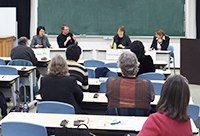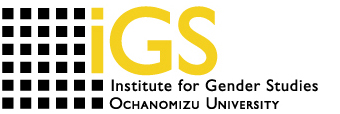International Symposium “Gender, Religion, and Social Reform in the Meiji Period: The Case of Sumiya Koume and Nakagawa Yokotarō”
The title of the keynote speech was “‘Jesus Stole My Mistress’: Nakagawa Yokotarō and Sumiya Koume and Changing Lives in Nineteenth-Century Japan.” Japan opened its borders to the West in the late Edo period. Within the regional history of Okayama, Anderson examined two aspects of the social change following the Meiji Restoration, including how people’s ways of thinking and gender relations changed and how Christianity was involved in that change. Anderson is taking a new approach in her methodology. Conventional studies tend to analyze men and women separately, but she focuses on a couple. Through examining the change in a couple’s relationship, we can trace gender relations in detail and their changes in the society of that time.
Nakagawa was born in 1836 in a Confucian scholars’ family that served Ikeda daimyo of the Okayama domain. After the Meiji Restoration, he actively worked on social reform for the modernization of Okayama society. Sumiya was born in 1850. She was the daughter of a law-level samurai family, and her parents died of illness when she was still a child. To make a living, she became a geisha, as she was good at playing the shamisen. Then she met Nakagawa and became his concubine. She lived with Nakagawa, his wife, their two sons, and her daughter. Their encounter with Christianity changed their lives. The first Christian missionary was brought to Okayama in 1875 by Nakagawa. Nakagawa and Sumiya heard of women’s schools opened by missionaries in Japan. In 1878, twenty-eight-year-old Sumiya entered one of these schools, called Kobe Home (present Kobe College). At the school, Sumiya studied Christianity’s teachings and learned that concubinage was a sin, so she left Nakagawa in 1881. The quotation in the title of Anderson’s keynote speech, “Jesus Stole My Mistress,” was Nakagawa’s comment on this incident. Ironically for Nakagawa, bringing a Christian missionary to Okayama resulted in Sumiya’s separation from him.
Even after their separation, both continued to work for social reform in Okayama, and their social networks overlapped, but the differences in their attitudes toward Christianity separated them. For Nakagawa, Christianity and missionaries were sources of Western culture, technology, and knowledge. Even though he utilized missionaries for his purposes, he did not care to be converted to Christianity. He did not hide his anger toward some Christian teachings, such as its objection to the concubine system and its promotion of temperance. On the other hand, Sumiya discovered a new subjectivity in Christianity. She decided not to be concubine anymore, expanded the field of her activity, and took a new role as the leader of regional society. Anderson noted that this was a way to exceed the contemporary ryosai-kenbo ideology that required women to be good wives and wise mothers. Nakagawa and Sumiya actively changed their lives and developed their new roles in a new society, but they did not recast all their elements. There were aspects that continued from the past and were sustained. Anderson stressed that looking at the lives of Nakagawa and Sumiya and providing detailed analyses of them in parallel can foster greater understanding of how modernization in Meiji affected individual men and women.
Dr. Schicketanz made comments stemming from his research into the interaction between Buddhism and modernity in China and Japan. At first, he pointed out that Christianity in this context is Protestant and conversion to Protestant Christianity in a non-Western society can be regarded as conversion to modernity. There is an affinity between Protestantism and modernity. Both favor change, and such a conversion may foster the idea of the individual and the acquisition of a new subjectivity. Schicketanz indicated that not only did the teaching of Christianity criticize concubine system, but also this characteristic of conversion separated the tracks of Sumiya and Nakagawa. At the same time, it may have been that the differences in their understanding of individuality caused the gap between their ideas of social reform. Buddhist communities’ involvement in women’s education only started in the late 1880s, following the path of the Christian community. Contrary to the idea of natural rights that Christianity preached, Buddhism regarded the division of labor between men and women as the law of nature. Protestantism, however, often stressed the importance of women’s role at home too, and therefore conversion to Christianity does not necessarily mean women’s liberation from paternalism. Schicketanz expressed his appreciation of Anderson’s approach, which examines social change in the regional society of the Meiji period from a factual bottom-up social movement, rather than a top-down introduction of abstract national ideology by the government. Additionally, he suggested that investigating the reception of the national ideology and nationalism by Sumiya and Nakagawa could bring a new dimension to Anderson’s research.
Dr. Ishii’s informative comments taught the audience about the activity of female American missionaries in Japan and to understand the draw to Sumiya of social reform. After the conversion, Sumiya worked as a so-called Bible woman and established her position as an influential figure in the welfare and education sectors in Okayama through that activity. Bible women helped foreign missionaries by visiting Japanese homes to tell people about the Bible. Foreign missionaries could not travel freely in inland Japan, and some did not have enough knowledge of Japanese culture or language to tell people of their mission. The Bible women were a very successful part of the strategy of the foreign missionaries, who converted women at first and their family members next, through them. It is also said that the Bible women became a new role model for Japanese women of that time, changing their lifestyle after conversion. Sumiya developed her social network through this activity and contributed to society not only within the church but outside. As a result, she became one of the most influential Bible women in Okayama. Certain social characteristics of Okayama that time enabled the region to achieve distinctive social reform. It had a relatively large number of Protestant Christians, who were distributed in a wide range of social classes, and a close relationship between the church and leaders in the society, who were working to develop new welfare systems. Speaking of the continuity from the past that Anderson had also discussed, Ishii suggested that apart from the new church-led social network, women’s networks of mutual support originated in the Edo period.
In the following discussion session, comments from different point of views came from the audience, such as the comparison of Japanese missionaries to missionaries in Korea, the contribution of the Onishi family (Nakagawa’s wife’s parents) to the education sector, and the role of women in social reform and founding women’s schools. In the symposium, the audience and the speakers were able to explore the possibility of extending their interest and to achieving a better understanding of history by focusing on the lives of one couple and their gender relations. We are very much looking forward to the publication of Anderson’s new book on this research project.
Kumi Yoshihara (Project Research Fellow, IGS)

Date/Time: Jan. 17, 2017 18:30-20:00
Seminar Venue: Room 306, Main Building, Ochanomizu University
Language: English only
Speakers:
Marnie S. Anderson (Smith College) “Jesus Stole My Mistress”: Nakagawa Yokotarō and Sumiya Koume and Changing Lives in Nineteenth-Century Japan
Commentators:Erik Schicketanz (JSPS / The University of Tokyo), Noriko Ishii (Sophia University)
Coordinator/Moderator: Laura Nenzi(IGS, Ochanomizu University/ University of Tennessee)
Organizer: Institute for Gender Studies, Ochanomizu University
Number of Participants: 26

